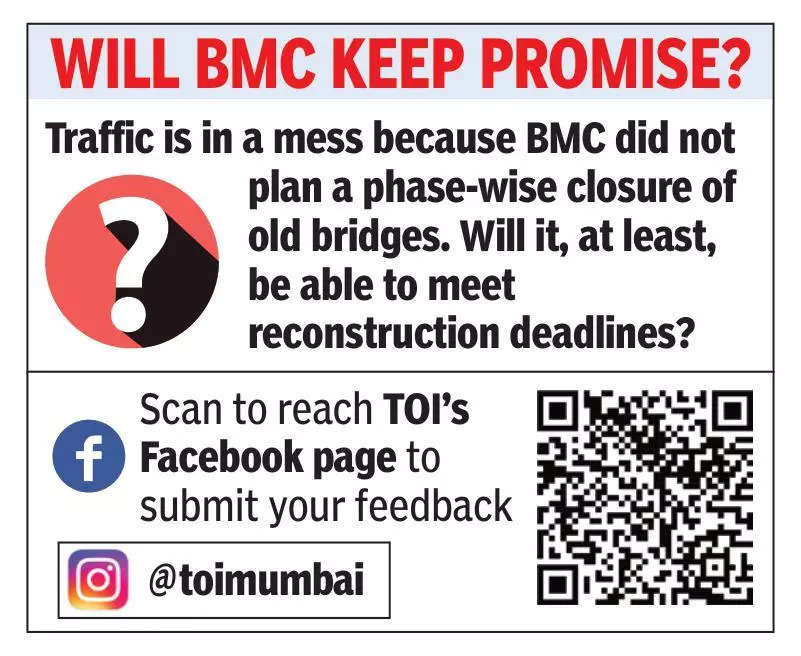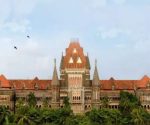AS british bridges are replaced, TRAFFIC TURMOIL likely Till 2030 – The Times of India

Why is driving in Mumbai, especially in its southern parts, so miserable despite the opening of the Coastal Road? It turns out that the city’s already choked heart is beating without four key arterial road over-bridges (ROBs), and this number will soon increase by two more. These British-era bridges are either under reconstruction (Bellasis at Mumbai Central, Carnac at Masjid Bunder and Reay Road ROB), or being demolished (Sion ROB). Two more, the Elphinstone and Dharavi ROBs, are set to be demolished soon. While civic authorities maintain that the bridges will be opened this year, suggesting a reconstruction period of just over two years, the city’s history of delays in similar projects raises concerns. These fears are heightened by the BMC’s refusal to disclose the percentage of work completed.
In the north, the woes of congested Andheri were compounded when, in addition to the closure of several minor bridges (see box), the 1975-built Gokhale bridge, a key east-west suburban connector, was closed in 2022 because of weak structural stability. It has only been partially opened, with its reconstruction unfinished. Experts say bridge closures don’t just affect traffic locally, but have a ripple effect for miles on end. Also, while the authorities declare reconstruction deadlines of a year or a couple of years, experience shows that demolished bridges can take more than half a decade to come up again — Hancock ROB at Mazgaon being a typical example.
As the city overhauls its British-era ROBs, commuters are bracing for extended traffic disruptions, which could persist until at least 2030. These ageing stone or cast iron structures, once vital for east-west connectivity across the city’s extensive railway network, are being demolished and replaced to accommodate modern infrastructure and additional railway tracks. But delays and poor coordination between authorities threaten to paralyze south Mumbai for years, potentially undermining the benefits of finished or almost-ready mega-projects like Atal Setu (Mumbai Trans Harbour Link, or MTHL) and the Coastal Road.
With the old bridges gone—some, like Carnac, having stood the test of time for over 150 years—the city will turn a chapter. Many of the city’s pre-Independence bridges were built with basalt stone and a steel superstructure. Most used riveted steel girders for the main structural framework. In older structures, cast iron elements were used, especially for railings and supports. While the iron was brought from Britain, supplied by major steel manufacturers such as Cleveland, the abutments and piers were typically built using locally available stone and brick masonry. The metal framework would be fabricated in England and shipped to Mumbai for assembly; the manufacturer’s mark can still be seen on many of these historic bridges.
The cumulative reconstruction cost of the bridges works out to around Rs 2,250 crore, not accounting for cost overruns caused by delays. “This is all the more reason for the BMC to honour deadlines,” said a concerned citizen.
While officials promise that projects will be completed within two years, experience suggests otherwise. Hancock Bridge, for example, was demolished in 2016 with a projected completion date of 2019, but it didn’t reopen until 2022. Similarly, Carnac Bridge, remains under construction with no clear timeline for completion, though the BMC has promised that it will reopen this May.
In June 2022, the Comptroller and Auditor General (CAG) criticized the lack of coordination and irregularities in the handling of the Hancock and Carnac bridge works. Additionally, Delisle Bridge at Lower Parel, closed in 2018, took nearly five years to reopen, highlighting ongoing delays. Historian Sharada Dwivedi shared with TOI in 2004 that most of Mumbai’s bridges were built over railway lines to avoid the long delays caused by level crossings, which were exacerbated by suburban trains. At the time, there were two main railway lines in the city: the Great Indian Peninsular Railway (GIPR), which became Central Railway, and the Bombay, Baroda and Central India Railway (BBCIR), which became Western Railway.
In the north, the woes of congested Andheri were compounded when, in addition to the closure of several minor bridges (see box), the 1975-built Gokhale bridge, a key east-west suburban connector, was closed in 2022 because of weak structural stability. It has only been partially opened, with its reconstruction unfinished. Experts say bridge closures don’t just affect traffic locally, but have a ripple effect for miles on end. Also, while the authorities declare reconstruction deadlines of a year or a couple of years, experience shows that demolished bridges can take more than half a decade to come up again — Hancock ROB at Mazgaon being a typical example.
As the city overhauls its British-era ROBs, commuters are bracing for extended traffic disruptions, which could persist until at least 2030. These ageing stone or cast iron structures, once vital for east-west connectivity across the city’s extensive railway network, are being demolished and replaced to accommodate modern infrastructure and additional railway tracks. But delays and poor coordination between authorities threaten to paralyze south Mumbai for years, potentially undermining the benefits of finished or almost-ready mega-projects like Atal Setu (Mumbai Trans Harbour Link, or MTHL) and the Coastal Road.
With the old bridges gone—some, like Carnac, having stood the test of time for over 150 years—the city will turn a chapter. Many of the city’s pre-Independence bridges were built with basalt stone and a steel superstructure. Most used riveted steel girders for the main structural framework. In older structures, cast iron elements were used, especially for railings and supports. While the iron was brought from Britain, supplied by major steel manufacturers such as Cleveland, the abutments and piers were typically built using locally available stone and brick masonry. The metal framework would be fabricated in England and shipped to Mumbai for assembly; the manufacturer’s mark can still be seen on many of these historic bridges.
The cumulative reconstruction cost of the bridges works out to around Rs 2,250 crore, not accounting for cost overruns caused by delays. “This is all the more reason for the BMC to honour deadlines,” said a concerned citizen.
While officials promise that projects will be completed within two years, experience suggests otherwise. Hancock Bridge, for example, was demolished in 2016 with a projected completion date of 2019, but it didn’t reopen until 2022. Similarly, Carnac Bridge, remains under construction with no clear timeline for completion, though the BMC has promised that it will reopen this May.
In June 2022, the Comptroller and Auditor General (CAG) criticized the lack of coordination and irregularities in the handling of the Hancock and Carnac bridge works. Additionally, Delisle Bridge at Lower Parel, closed in 2018, took nearly five years to reopen, highlighting ongoing delays. Historian Sharada Dwivedi shared with TOI in 2004 that most of Mumbai’s bridges were built over railway lines to avoid the long delays caused by level crossings, which were exacerbated by suburban trains. At the time, there were two main railway lines in the city: the Great Indian Peninsular Railway (GIPR), which became Central Railway, and the Bombay, Baroda and Central India Railway (BBCIR), which became Western Railway.
















